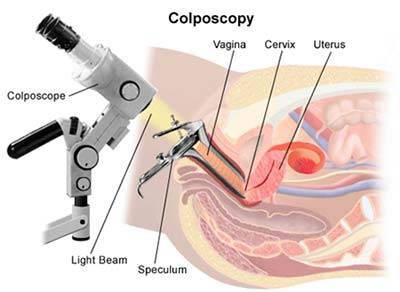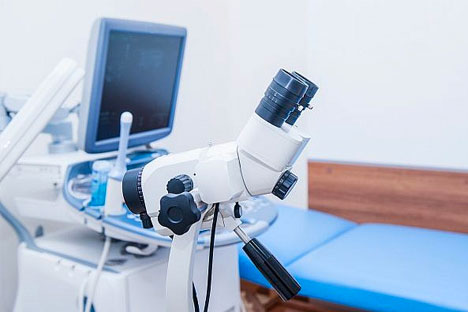Colposcopy
 A colposcopy usually is performed by your gynecologist in response to an abnormal Pap smear. The reasons for an abnormal Pap smear can vary greatly, but they are caused most commonly by viral infections, such as the human papillomavirus (HPV). The purpose of this procedure is to examine your vagina, vulva, and cervix.
A colposcopy usually is performed by your gynecologist in response to an abnormal Pap smear. The reasons for an abnormal Pap smear can vary greatly, but they are caused most commonly by viral infections, such as the human papillomavirus (HPV). The purpose of this procedure is to examine your vagina, vulva, and cervix.
Other types of infections might include:
- Yeast (fungi)
- Bacteria
- Protozoa (Trichomonas)
If a Pap test indicates the presence of viruses, infections, or cervical cells, then your medical practitioner must be able to determine the source of the problem. Abnormal Pap test results may also result from naturally occurring cervical cell changes called atrophic vaginitis related to menopause. These cervical cell changes continue to grow and lead to such severe complications as cancer if left untreated.
Your gynecologist offers comprehensive Obstetrics & Gynecology care for women of all ages. At our ob-gyn clinic, we provide a full range of gynecologic services, from annual check-ups and routine pap smears to treatment of Abnormal Uterine Bleeding and GYN procedures.
How a Colposcopy Works
It begins with another Pap smear test and an HPV test if you haven’t recently had one. Your doctor cleanses you with a vinegar solution to make some types of abnormal cells visible. A lighted magnifying device that roughly resembles binoculars, called a colposcope, enables your OBGYN to see issues that the naked eye could well overlook.
Your doctor may decide to take pictures or even videos of your cervix and vagina through a tiny camera attached to the end of the colposcope. If any suspicious or questionable areas are visible, your OBGYN can take a tissue sample (also known as a biopsy) from inside the cervix without having to perform another procedure. Your doctor will then send the samples taken from your cervix to a pathologist for laboratory examination.
Three types of biopsies commonly used during colposcopy include:
Preparing for a Colposcopy
Try to schedule your appointment for a week that you’re not on your period.
Be sure to tell your doctor if you:
- Are pregnant
- Have any allergies to medication
- Are taking medications
- Were previously treated for cervical, vaginal or pelvic infections
- Have bleeding problems or take blood thinners
During the Colposcopy Procedure in NYC
 The vinegar solution your doctor uses on your cervix may feel a bit cool, but not much and not for very long. If any abnormal spots are detected, and the biopsy is necessary, your doctor uses a small device to snip away minute tissue samples from your cervix. In rare cases, you may experience discomfort like a mosquito bite up to a slight bee sting during the process.
The vinegar solution your doctor uses on your cervix may feel a bit cool, but not much and not for very long. If any abnormal spots are detected, and the biopsy is necessary, your doctor uses a small device to snip away minute tissue samples from your cervix. In rare cases, you may experience discomfort like a mosquito bite up to a slight bee sting during the process.
You may feel a pinching or cramping sensation during the procedure. You may spot or bleed following a biopsy. If there is bleeding, it should only last a day or so. If the bleeding persists, call the Upper East Side gynecology or Midtown gynecology in Manhattan. Bleeding after colposcopy can be stopped using a cotton swab to apply a solution to the cervix that looks like peanut butter and helps the cervix heal faster.
Risk and Recovery
The risk of complications following a colposcopy is very minimal since this procedure is simply an examination. However, if a biopsy is necessary, there is a small risk of bleeding and infection that may require additional treatment. Cramping, light bleeding, and discharge are possible for a few days following the biopsy.
There is also a slight chance that you may experience fever, chills, or pelvic pain. Restricted activities will vary depending on the technique used to collect your biopsy. To allow for proper healing, using tampons and douches, lifting heavy objects, and having sex after colposcopy is discouraged several weeks after the biopsy.
Colposcopy During Pregnancy
A colposcopy is performed in pregnant women to determine if there is invasive cancer. Since the procedure is more difficult in a pregnant woman due to several factors, such as increased mucus production and gland prominence, only an experienced OBGYN should conduct it. Talk to your doctor before the procedure, so you’re comfortable with it.
Since a pregnant cervix tends to bleed slightly more than someone who is not pregnant, your gynecologist may weigh the options of waiting to do certain parts of the colposcopy until you are no longer pregnant. Generally, biopsies only are performed on pregnant women if all the evidence points to an extreme risk of cancer or dysplasia. If done right, a colposcopy won’t harm you if you’re pregnant, and it won’t hurt your baby.
Most people have zero pain during a colposcopy—however, some may experience minor discomfort.
Colposcopy HPV (Detecting the Human Papillomavirus)
The main focus of a colposcopy exam is to prevent cervical cancer by detecting its warning signs early enough to treat the problems that can cause it. The HPV virus is a sexually transmitted disease with positively staggering statistics. It comprises more than 100 different viruses, 30 of which cause varying types of cancer.
The only way to avoid the virus is to abstain from direct sexual contact, oral, vaginal, or anal. HPV can cause genital warts that appear in batches that resemble cauliflower inside and outside your vagina. It could take weeks, months, or years for symptoms to appear. In some cases, visible symptoms never manifest. There are no HPV tests available for men. There is no cure for HPV, but in our gynecology center, we offer a vaccine that helps prevent several strains of HPV, and your body sometimes can clear the virus from your system naturally.
Colposcopy for Endometriosis
In endometriosis, the womb lining grows in different places, including your ovaries, your fallopian tubes, behind your uterus, or your bowels or bladder. In some rare cases, the tissue can occur in other parts of the body.
It’s known to occur in an estimated six to 10 percent of women. These areas of growth can bleed and result in swelling and scarring. However, these growths are not cancerous and need a combination of symptoms and medical exams to determine the correct diagnosis.
Your doctor can tell immediately if abnormal growths or areas are visible on your cervix. It only takes days to get the results after performing a biopsy. Your doctor may recommend additional testing depending on your results. You may have to wait until your cervix has healed from the initial biopsy before undergoing these tests.
Have questions about the Colposcopy procedure? Schedule an appointment with internationally recognized, top-rated GYN specialist of Manhattan Women’s Health and Wellness today.
Updated on Sep 23, 2023 by Manhattan Women’s Health and Wellness
Best-in-class
New York Gynecology Clinic
Manhattan Specialty Care in the Press

Call now to make an appointment with our highly rated Manhattan Gynecology doctors regarding your health. We look forward to seeing you!
book online now
(212) 378-9985
New York City Locations:
Manhattan Women's Health & Wellness (Upper East Side)
983 Park Ave, Ste 1D17
New York, NY 10028
(212) 389-1904
Manhattan Women's Health & Wellness (Midtown)
56 W 45th St, Ste 815
New York, NY 10010
(212) 677-7654
Manhattan Women's Health & Wellness (Union Square)
55 W 17th St, Ste 104
New York, NY 10011
(212) 378-9985